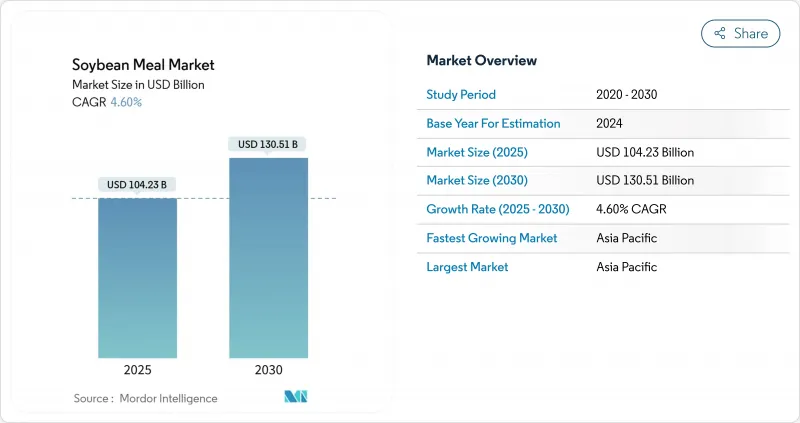
|
市場調査レポート
商品コード
1850366
大豆粕:市場シェア分析、産業動向、統計、成長予測(2025年~2030年)Soybean Meal - Market Share Analysis, Industry Trends & Statistics, Growth Forecasts (2025 - 2030) |
||||||
カスタマイズ可能
適宜更新あり
|
|||||||
| 大豆粕:市場シェア分析、産業動向、統計、成長予測(2025年~2030年) |
|
出版日: 2025年06月23日
発行: Mordor Intelligence
ページ情報: 英文 120 Pages
納期: 2~3営業日
|
概要
大豆粕市場規模は2025年に1,042億3,000万米ドルと推定・予測され、予測期間中(2025~2030年)のCAGRは4.60%で、2030年には1,305億1,000万米ドルに達すると予測されます。

このような軌道は、コスト効率の高いタンパク質原料に対する世界的な需要の底堅さと、大豆破砕能力の増加を促す再生可能ディーゼル政策の影響力の高まりを反映しています。サプライチェーンは、EUの森林破壊防止規制がトレーサビリティー証明の必要性を貿易業者に促し、アジア太平洋の養殖業の成長が商品価格の不安定さにもかかわらず輸入の大きな流れを支えていることから、再調整されつつあります。2024年に1,440万トンという記録的な米国の大豆粕輸出は、石油主導の圧搾マージンの拡大によって生じた余剰食用油を市場に振り向ける能力を裏付けています。同時に、カビ毒の管理コストと天候による生産量の変動が引き続き営業利益率を圧迫しているため、加工業者は品質保証とロジスティクスの最適化に投資する必要に迫られています。
世界の大豆粕市場の動向と洞察
高タンパク質飼料製剤に対する需要の高まり
飼料は家畜の生産コストの60-70%を占めるため、配合業者は単価あたりのアミノ酸供給量を最大化するタンパク質源へと向かっています。大豆粕は一貫してバランスの取れたアミノ酸プロファイルを提供し、新品種では平均37.7%の粗タンパク質を実現しているため、精密な鶏肉および豚肉飼料における優位性を強化しています。ブロイラー用飼料は、2017年から2022年にかけて21.5%増加した後、家禽飼料に使用されるミールの66.2%を吸収しています。東南アジアにおける食肉消費の急成長がこの動きを加速させる一方、大豆品種の遺伝的改良により、可変性のある代替野菜よりも消化率が向上しています。
水産養殖用飼料の生産能力拡大
水産養殖は最も急成長している動物性タンパク質セクターであり、エビ、ティラピア、ナマズ用の飼料には通常、消化性とアミノ酸のニーズを満たすために30~35%の大豆粕が含まれています。飼料メーカーのVimifosが大豆を多く含む配合飼料でメキシコ市場シェアの21%を獲得しているように、メキシコのエビ部門だけでも米国の大豆粕を大幅に消費しています。発酵ミールは抗栄養因子を低下させ、飼料要求率を向上させ、押出技術は消化率をさらに向上させ、昆虫タンパク質の実験にもかかわらず、大豆粕の役割は確固たるものとなっています。
天候とバイオ燃料政策によって変動する大豆価格
干ばつ、洪水、為替変動が価格変動を激化させ、飼料配合業者の調達を複雑にしています。ブラジルのリオグランデ・ド・スル州では洪水により2024年産が271万トン減産となったが、米国では2025年1月のWASDEレポートで収量減産幅が縮小され先物市場を驚かせ、世界的な在庫が記録的な高水準に近づいているにもかかわらず、強気の上昇を引き起こしました。再生可能ディーゼルの需要は、国内の石油供給を引き締めることで変動を誇張し、粉砕業者に積極的なマージンヘッジを余儀なくさせ、川下のミールバイヤーのリスクを高めています。
セグメント分析
動物飼料は依然として大豆粕市場の中心であり、2024年の市場全体の77.3%を占める。ブロイラーのインテグレーターは、リジンベースの代替タンパク質が頭打ちになるにつれて大豆粕の配合率を引き上げ、このセグメントの基準年の大豆粕市場規模への寄与を800億米ドルに押し上げました。養豚では、飼料用アミノ酸の採用が増加したため数量は減少したが、精密栄養処方がバランスの取れたタンパク質コーティングに傾いたため、全体的な飼料効率の向上により需要は維持されました。水産養殖用飼料は、消化率を向上させる酵素強化ミールによって飼料ブロックの中で最も急速に成長し、アジアの輸入貨物への依存度を高めています。
工業用およびバイオベース用途は、接着剤、潤滑剤、屋根用シーリング材に大豆粕の再生可能なタンパク質および繊維分画を利用する製造業者により、全用途の中で最も早いCAGR 5.9%で成長すると予測されます。アイオワ大豆協会と消費者ブランドとのパートナーシップにより、大豆ベースのバーアンドチェーンオイルがすでに商品化されており、アイオワ研究所では風力タービン用複合材への利用を拡大するパイロットプロジェクトを進めています。こうした取り組みが拡大すれば、2030年までに大豆粕市場規模の10%を占めるようになり、粉砕工場での引き取り戦略に柔軟性が増し、飼料主導の需要サイクルが緩和される可能性があります。
大豆粕市場レポートは用途別(動物飼料、その他)、地域別(北米、南米、その他)に分類されています。生産分析(数量)、消費分析(金額と数量)、輸出分析(金額と数量)、輸入分析(金額と数量)、価格動向分析を含みます。市場予測は金額(米ドル)と数量(メトリックトン)で提供されます。
地域分析
アジア太平洋は2024年の金額の38.2%を占め、2030年までCAGR 6.2%で大豆粕市場を拡大すると予測されます。中国は2024年に8,060万トンの大豆粕を消費するが、家畜飼料の生産量は飼料効率の改善と疾病発生後の豚群の正常化により若干減少しました。ベトナム、フィリピン、バングラデシュはいずれも輸入を引き上げ、インドの国内使用量770万トンは、酪農、養鶏、水産分野でのタンパク質摂取量の増加を示しています。東南アジアの水産養殖施設の規模が拡大するにつれて、地域の粉砕業者は需要に見合うよう奮闘し、不安定な価格設定体制下でも輸入の持続的な伸びを確保しています。
北米は、大容量の破砕ネットワークと拡大するバイオ燃料政策を通じて、世界の供給を支えています。米国の大豆圧砕量は2024年に前年比5.4%増の6,560万トンに達し、中西部の新プラントによって2026年までに1日当たりの処理量はさらに14億ブッシェル増加します。バートレット社のカンザス工場(3億7,500万米ドル)のような資本プロジェクトは、再生可能ディーゼルの目標に関する官民の協調を示すもので、メキシコ、カナダ、アジアのバイヤーが利用できる国内ミール余剰の拡大に直結します。
南米は、生産量の多さと物流の多様化を兼ね備えています。ブラジルは2024年に4,240万トンの大豆粕を生産し、2,120万トンを輸出しました。アルゼンチンの輸出量は干ばつからの回復により37%増の4,240万トンとなり、輸出減税とパイプラインの改善により生産能力が回復したため、輸出トップの座を回復しました。パラグアイとウルグアイは、アジアの需要を取り込むために河川と鉄道への投資を活用し、小規模ながら堅調に拡大しています。とはいえ、政策の安定性、輸送のボトルネック、EUの持続可能性基準の変化が、この地域の世界市場シェアへの長期的な寄与を左右すると思われます。
その他の特典:
- エクセル形式の市場予測(ME)シート
- 3ヶ月間のアナリストサポート
よくあるご質問
目次
第1章 イントロダクション
- 調査の前提条件と市場の定義
- 調査範囲
第2章 調査手法
第3章 エグゼクティブサマリー
第4章 市場情勢
- 市場概要
- 市場促進要因
- 高タンパク質動物飼料配合の需要増加
- 養殖飼料生産能力の拡大
- バイオ燃料の需要増加により大豆の圧搾量増加
- 森林破壊のない調達義務が世界貿易ルートの再構築を義務付ける
- 取引と物流コストを削減するリアルタイムデジタル商品プラットフォーム
- 昆虫と大豆粕の混合飼料の導入により、大豆粕の利用が全体的に向上
- 市場抑制要因
- 天候とバイオ燃料政策の影響で大豆価格が変動
- マイコトキシン汚染事件により品質規制が強化される
- 代替高タンパク食との競合
- ESG関連金融は土地利用の変化に関連する大豆粕を罰する
- バリューチェーン/サプライチェーン分析
- 規制情勢
- テクノロジーの展望
- PESTEL分析
第5章 市場規模と成長予測(価値と量)
- 用途別
- 動物飼料
- 食品・飲料加工
- 工業製品およびバイオベース製品
- 地域別(生産分析(量)、消費分析(金額と量)、輸入分析(金額と量)、輸出分析(金額と量)、価格動向分析)
- 北米
- 米国
- カナダ
- メキシコ
- 欧州
- スペイン
- クロアチア
- フランス
- ドイツ
- ロシア
- アジア太平洋地域
- インド
- 中国
- バングラデシュ
- 南米
- ブラジル
- アルゼンチン
- ウルグアイ
- 中東
- アラブ首長国連邦
- サウジアラビア
- アフリカ
- 南アフリカ
- エジプト
- 北米
第6章 競合情勢
- List of Key Stakeholders

